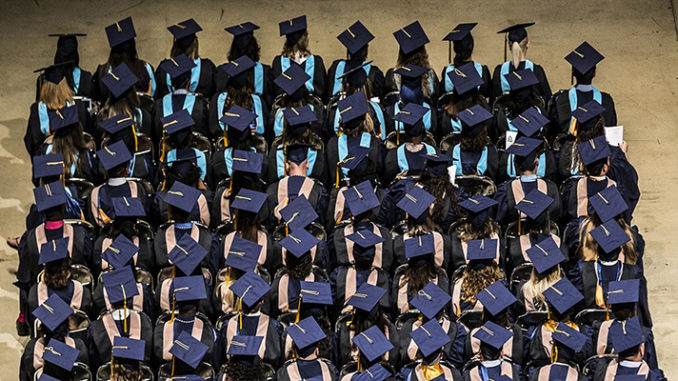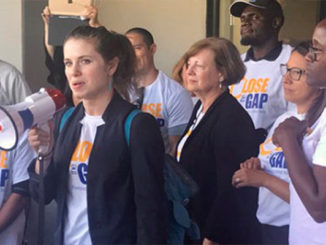
by Nat Malkus
Last week, America’s Promise released its 2019 “Building a Grad Nation” report monitoring the nation’s progress toward a 90% public high school graduation rate. It celebrated the progress made between 2011 and 2017, wherein each year saw record graduation rates, and the percentage of non-graduates dropped by a quarter. It also implored greater focus, noting that to meet its goal by 2020, schools would have to double their rate of progress.
A 90% goal is nothing if not ambitious, as it would cut the percentage of non-graduates by more than half in ten years. America’s Promise wants more students—especially marginal students at the greatest risk of dropping out—to leave school “prepared to immediately enter postsecondary education or the workplace.” So do we all, but ambitious statistical targets like a 90% graduation rate, especially when sought quickly, are dangerous because they are as likely to produce empty victories as improved outcomes, especially for the marginal students the targets are purported to help.
One reason a 90% target is problematic is because all graduation requirements aren’t equal, and therefore, neither are graduation rates. Kentucky, the state with the 4th-highest grad rate in 2017, at 89.7 percent, is an excellent example. So close to the 90% goal, it may seem odd that Education Commissioner Wayne Lewis recently sought to toughen the state’s graduation requirements, which would inevitably send grad rates lower. The problem is that Kentucky’s graduation requirements are so weak that more than a third of graduates get a meaningless diploma, one that does not come with the “skills necessary to succeed in college or the workplace.” Lewis is rightly prepared to knowingly forego Kentucky’s enviable spot on the road to 90%, precisely because maintaining it would allow more, not fewer, graduates to leave school unprepared.
Of course, most states have more rigorous graduation requirements, and lower grad rates, than Kentucky, and I worry that these may be willing to lower the academic bar, especially for struggling students, to meet ambitious graduation rates targets. The authors of the America’s Promise report address this head on with a new Secondary School Improvement Index (SSII), which combines states’ increases on 8th-grade math and reading proficiency on the National Assessment of Educational Progress (NAEP) and Advanced Placement (AP) test passage, as a check on whether graduation rates are rising alongside—rather than in spite of—other indicators. They find little evidence “that increases in high school graduation rates have come at the expense of academic outcomes and levels of postsecondary preparation.”
Unfortunately, their conclusion is unconvincing. The SSII is rife with problems. The scores largely align with their grad-rate increases, with a moderate correlation of 0.6, but that is wholly because the grad-rate increases are part of the index. If the index took grad-rate growth out of its index, and compared it to just test scores and AP passage increases, the correlation would fall below 0.1.
Now, 8th-grade NAEP is a lousy indicator of high school quality, chosen more for its availability (12th-grade NAEP scores aren’t available at the state level) than its value. However, if America’s Promise had to use NAEP, the SSII should have used the percentage of students scoring above “Basic” (Proficiency is a relatively high standard), which is a score closer to the floor of graduation requirements in most states. In familiar terms, scoring Proficient on NAEP means you are at least a B+ student, not the marginal students we typically worry will drop out; scoring Basic means you are a solid C. And in the end, it’s the states that can push more marginal D students to solid C territory that will legitimately raise graduation rates.
Between 2011 and 2017, most states increased the percentage of 8th graders who met Proficiency. Only eight lost ground in reading, while 30 did so in math. However, if the SSII focused on the marginal students, using the more appropriate Basic benchmark, the picture looks bleaker. In reading, 28 states had fewer students reaching Basic, as did 44 in math. To the degree these 8th-grade tests reflect high school progress, using the “Basic” benchmark that focuses on marginal students makes the grad-rate increases look hollow.
Focusing attention on these marginal students is vital if we want to see higher graduation rates and more students prepared for the future. These marginal students need the most assistance, are the most expensive to educate, and are the most likely to see the bar lowered. What’s more, these students are clustered in a subset of high schools. The report notes that the 12% of high schools with extremely low graduation rates account for 30% of non-graduates. The bulk of the pressure to reach a 90% graduation rate, through legitimate or illegitimate means, falls on these students and schools.
To its credit, the report does flag concerns about graduation rate inflation, recommending that we “probe deeper on credit recovery programs”—accelerated make-up courses which have a long anecdotal record of abuses. That concern is appropriate, as schools with the highest credit recovery participation displayed an array of student disadvantages and poor student outcomes, but still managed to post higher average graduation rate increases than schools with less credit recovery, for four years running.
Despite this brief note of caution, the report’s hard push to increase graduation rates is problematic precisely because its SSII is such a halfhearted check on lowered expectations. On net, it pumps up pressure for better numbers, without serious attention to what those numbers mean. To get schools to graduate more prepared students, scorekeepers like America’s Promise need to put more earnest attention to how schools prepare more marginal students for life after high school, or they may meet their target without reaching their goal.



